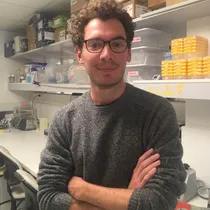- Accueil >
- Publications >
- A conserved transcriptional program for MAIT cells across mammalian evolution
A conserved transcriptional program for MAIT cells across mammalian evolution
Auteurs
Hélène Bugaut, Yara El Morr, Martin Mestdagh, Aurélie Darbois, Rafael A. Paiva, Marion Salou, Laetitia Perrin, Mariela Fürstenheim, Anastasia du Halgouet, Linda Bilonda-Mutala, Anne-Laure Le Gac, Manon Arnaud, Ahmed El Marjou, Coralie Guerin, Atitheb Chaiyasitdhi, Julie Piquet, David M. Smadja, Agata Cieslak, Bernhard Ryffel, Valdone Maciulyte, James M.A. Turner, Karine Bernardeau, Xavier Montagutelli, Olivier Lantz, François Legoux
Résumé
Mucosal-associated invariant T (MAIT) cells harbor evolutionarily conserved TCRs, suggesting important functions. As human and mouse MAIT functional programs appear distinct, the evolutionarily conserved MAIT functional features remain unidentified. Using species-specific tetramers coupled to single-cell RNA sequencing, we characterized MAIT cell development in six species spanning 110 million years of evolution. Cross-species analyses revealed conserved transcriptional events underlying MAIT cell maturation, marked by ZBTB16 induction in all species. MAIT cells in human, sheep, cattle, and opossum acquired a shared type-1/17 transcriptional program, reflecting ancestral features. This program was also acquired by human iNKT cells, indicating common differentiation for innate-like T cells. Distinct type-1 and type-17 MAIT subsets developed in rodents, including pet mice and genetically diverse mouse strains. However, MAIT cells further matured in mouse intestines to acquire a remarkably conserved program characterized by concomitant expression of type-1, type-17, cytotoxicity, and tissue-repair genes. Altogether, the study provides a unifying view of the transcriptional features of innate-like T cells across evolution.
Equipes







